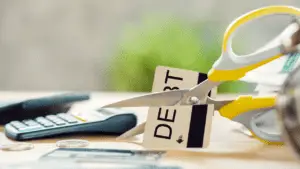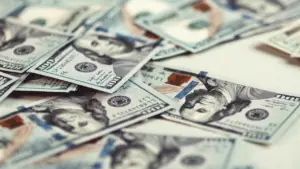Last Updated on April 22, 2023 by – Moneyinfo99.com Team
Are you feeling overwhelmed by the amount of credit card debt you are carrying? Do you feel like there’s no way out and that it will take years to pay off? The good news is, it doesn’t have to be that way.
With a little bit of effort and dedication, you can drastically reduce your credit card debt in a relatively short period of time. In this article, we’ll share 10 tips on how to pay off credit card debt quickly.
Benefits of Paying Off Credit Card Debt
Paying off credit card debt can feel overwhelming, but it’s worth the effort. It not only eliminates your financial worries, but there are many other benefits to paying off your credit card debt as well.
For one, you’ll be free from the high-interest rates that come with carrying a balance on your credit cards.

Paying off debt can help improve your credit score, which will make it easier for you to get approved for loans in the future.
Plus, when you pay off all of your debts, you’ll have more money available each month to save and invest—which is a great way to help secure your financial future.
You also won’t need to worry about late fees or other penalties if you don’t make payments on time since you won’t have any outstanding balances.
And having no debt will provide a sense of freedom – no longer will you feel like you need to watch every penny that comes out of your pocket!
Overall, paying off credit card debt is an investment in both your present and future self. Not only can it give you peace of mind today, but it also sets yourself up for greater financial success down the road.
So start now – take steps towards becoming debt-free and enjoy the many benefits that come along with it!
Tip 1- Identify the Card with the Highest Interest Rate
Paying off credit card debt can be a daunting task, especially when you have multiple cards with different interest rates.
The best way to get started is by identifying the card with the highest interest rate. This will be your starting point for paying off the debt and should be your focus until it’s paid in full.
By tackling the card with the highest interest rate first, you maximize how much of each payment goes towards paying down the balance rather than just being eaten up by interest costs.

Also, once that card is paid off, you’ll save money on interest payments each month which can then be used to pay down other cards faster.
If you need more help finding extra money to pay off debt faster, consider looking into balance transfer credit cards or taking out a personal loan.
These options may provide promotional periods with low-interest rates or no-interest at all which can help free up funds to put towards your debt repayment plan.
No matter what approach you take, remember that it’s important to stay consistent and focused on paying down your debt as quickly as possible so that you can enjoy financial freedom sooner rather than later!
The key to success in paying off credit card debt is to stay focused and consistent. By tackling the card with the highest interest rate first, you will be able to save more money on interest payments and get out of debt faster.
Now let’s turn our attention to how we can make even more progress by making more than the minimum payment – stay tuned for Tip 2!
Tip 2: Make More Than the Minimum Payment
Making more than the minimum payment on your credit card debt is a great way to pay it down faster.

By doing so, you can significantly reduce your total balance and save money on interest payments in the long run.
Plus, it’s easier than you might think to make more than the minimum payment each month. If you have extra cash from a tax refund or bonus at work, put that towards your debt instead of spending it elsewhere.
You can also set up automatic payments for certain amounts each month or look into taking out a personal loan or using a balance transfer card to help free up funds to pay off debts faster.
By making more than the minimum payment each month, you can make significant progress towards paying off your credit card debt quickly and efficiently.
So if you’re serious about getting out of debt, this is one tip that should definitely be on your radar!
Paying more than the minimum monthly payment is one of the best ways to quickly and efficiently reduce your credit card debt.
Taking advantage of this strategy can help you save money on interest payments in the long run and get out of debt faster.
So if you’re serious about tackling your debt head on, don’t forget to make more than the minimum payment each month! Now, let’s take a look at why it’s important to make more than the minimum payment on your debts.
Why Make More Than the Minimum Payment?
Making more than the minimum payment on credit card debt can be a great way to reduce your total balance and save money on interest payments.
It’s easier than you might think – if you have extra cash from a tax refund, bonus or other source of income, try putting that towards your debt instead of spending it elsewhere.
You could also set up automatic payments for certain amounts each month or look into taking out a personal loan to help free up funds to pay off debts faster.
By making more than the minimum payment each month, you can make significant progress towards paying off your credit card debt quickly and efficiently.
Plus, you’ll save money in the long run on interest payments as well. So if you’re serious about getting out of debt, this is one tip that should definitely be on your radar!
How to Calculate Your Monthly Payments
If you’re trying to pay off your credit card debt, it’s important to know how much you can afford to pay each month.
Calculating your monthly payments is easy – all you need is your total credit card balance and the interest rate(s) of your cards.
To figure out how much you should be paying each month, divide your total balance by the number of months in which you’d like to pay it off (for example, if you want to pay it off within 6 months, divide by 6).
Then take that amount and multiply it by 1 plus the interest rate(s) of your cards. This will be the amount that you need to budget for each month in order to get out of debt as quickly as possible.
Remember, paying more than the minimum payment on your credit cards will help reduce interest costs and shorten the length of time it takes for you to pay them off.
If you have extra money available from any source (such as a tax refund or bonus), consider using that money towards paying down your credit card debts faster!
Tip 3: Transfer High Interest Balances to Low Interest Cards
Transferring high-interest balances to low-interest cards is a great way to reduce the amount of interest you’re paying and get out of debt faster.
With balance transfer credit cards, you can move your existing debt from cards with higher interest rates to those with lower ones.
Many credit card companies offer promotional periods during which you can take advantage of an introductory period with no or low balance transfer fees and 0% APR for a certain period of time.
When transferring balances, it’s important to read the fine print on any offers as some cards may have hidden fees or restrictions.
Additionally, make sure to pay off your transferred balance before the promotional period ends so that you don’t wind up paying more in interest than you would have initially.
Lastly, it’s also a good idea to close out any old credit card accounts after transferring their balances in order to avoid any temptation to use them again.
By taking advantage of balance transfer credit cards and utilizing the different methods for repayment, you can work towards a debt-free future.
Ready to tackle your debt? Get ready to learn how the Snowball or Avalanche Method can help you pay off debt quickly!
Tip 4: Use the Snowball method or Debt Avalanche Method for Repaying Debts
If you’re looking for an effective way to pay off your credit card debts quickly, one of the best methods you can use is the Snowball or Avalanche Method.
This involves ranking your debts according to balance size and interest rate and then attacking them in that order.
The Snowball Method focuses on paying off your smallest debt first while making minimum payments on all your other debts.
This allows you to build momentum and confidence as you pay off each debt one-by-one. The Avalanche Method, on the other hand, prioritizes paying off high-interest debt first while also making minimum payments on all other debts each month.
Both methods have benefits and drawbacks, so it’s important to weigh them carefully before deciding which one is right for you.
Regardless of which method you choose, make sure to stay disciplined with your debt repayment plan by making timely payments and putting any extra money towards your debt whenever possible.
With dedication and determination, using either of these methods will help you become debt-free faster!
By applying the Snowball or Avalanche Method, you can make significant progress in your efforts to become debt-free.
With a little bit of discipline and dedication, you can get closer to achieving financial freedom! Now it’s time to tap into Tip 5: Take Advantage Of Intro Periods And Promotional Rates to help reduce your debt even faster.
Tip 5: Take Advantage Of Intro Periods And Promotional Rates
If you’re looking to pay off your credit card debt faster, one great way to do so is to take advantage of introductory periods and promotional rates.
Many credit cards offer a 0% APR for a certain amount of time, usually between 6-18 months, on balance transfers and/or purchases.
During this period, any payments you make towards the balance will go directly towards paying down the principal balance and not toward interest charges.
Additionally, some credit cards also offer promotional rates on purchases or cash advances during an intro period.
While these types of offers can be beneficial in helping you reduce your debt faster, it’s important to remember that they are often limited-time offers that come with certain restrictions or fees.
Make sure to read all the fine print before taking advantage of any offers so that you know exactly what you’re getting into.
By taking advantage of introductory periods and promotional rates, you can save significant amounts of money in interest charges while paying off your debt faster!
By taking advantage of introductory periods and promotional rates, you can pay off your credit card debt faster while saving a significant amount of money in the process.
Tip 6 – Create a Budget
Creating a budget is one of the best ways to get your credit card debt under control. It’s not always the most exciting thing to do, but it can be incredibly rewarding in the long run.

A budget is simply a plan for how you will manage and use your money each month. It takes into account all your fixed expenses (like rent or mortgage payments), variable expenses (like groceries or entertainment), and any income you may have coming in.
Once you have a good idea of what your expenses are, look at what you have left over and set aside an amount that you can commit to paying off your credit card debt every month.
The key to creating an effective budget is consistency—make sure that you track your spending and stick to the plan as much as possible.
You might also want to consider setting up automatic payments so that you don’t miss due dates, which could result in additional fees or higher interest rates on your balance.
Finally, try to think of creative ways to free up more money for debt repayment – maybe take on some extra work, sell some unwanted items, or cut back on eating out so that you can put more money towards paying off your debt each month.
Creating a budget and sticking to it is the best way to take control of your credit card debt.
With a little bit of planning, discipline, and creativity, you can get back on track and make real progress towards eliminating your debt for good. Ready to take the next step? Read on about the power of consolidating your debt!
Tip 7- Consolidate Your Debt
If you’re looking for a way to make paying off your credit card debt easier and faster, you might want to consider consolidating your debt.
Consolidating your debts means taking out a loan or opening one credit card account to pay off all of your other credit cards.
This can simplify things by allowing you to make one single payment each month instead of multiple payments to different creditors.
Consolidating your debt also has some financial benefits. When you open up a new account, it’s possible that the interest rate will be lower than what you’re currently paying on your existing accounts.
A lower interest rate means more of each payment goes towards paying down the principal balance rather than going towards interest charges.
Additionally, if you are able to transfer balances from high-interest cards onto a new card with an introductory 0% APR period, then you could save even more money over time as well.
Keep in mind that there are drawbacks associated with consolidating debt as well, such as balance transfer fees and possibly having to close existing accounts which could negatively affect your credit score.
It’s important to do research and weigh the pros and cons before making any decisions. If done properly though, consolidation can be an effective tool for quickly reducing or eliminating credit card debt.
Consolidating your debt can be a great way to make paying off credit card debt easier and faster, but it’s important to do research and weigh the pros and cons before making any decisions.
Tip 8 – Analyze Your Spending
If you’re serious about paying off your credit card debt, take a look at where your money is going each month.
A good way to start is by tracking all of your expenses over the course of a month and then categorizing them into categories such as food, entertainment, transportation, etc.
This will give you an accurate view of where your money is going and if there are any areas where you could be cutting back in order to free up more money for debt repayment.
You may also want to consider creating a budget based on your income so that you have an organized plan for how much you can realistically put towards debt payments each month.
Once you know what your available funds are, decide which debts should be paid first – usually it’s best to focus on high-interest debts first since they will cost more in the long run.
Finally, make sure that you stick to the budget and don’t forget to factor in extra payments whenever possible.
With some discipline and organization, analysing your spending can help you pay off credit card debt quickly and efficiently.
By taking the time to analyze your spending and create a budget that works for you, you can make sure that every dollar you earn goes towards paying off your credit card debt and ultimately achieving financial freedom.
Now that you have the tools to tackle your debt, it’s time to take the next step: stop using your credit cards!
Tip 9 – Stop Using Your Credit Cards
If you’re serious about getting rid of your credit card debt, the first and most important thing to do is to stop using your credit cards.
This means not only stopping all new purchases with them, but also ceasing any cash advances or balance transfers.
Additionally, if you’re having trouble staying away from your cards, try cutting them up or freezing them in a jar of ice as a reminder that they should not be used.
Although it may seem like an obvious solution, many people don’t realize how dangerous using their cards can be when they are trying to pay off their debts.
Even if you are making payments on time each month, the interest on those payments can quickly add up and make it much more difficult for you to become debt free.
By avoiding the use of your credit cards altogether until your debts are paid off in full, you can greatly reduce the amount of money you will end up paying back in interest over time.
Of course, there may be times when it is necessary to use a credit card for emergency situations or large purchases where cash isn’t an option.
However, if this happens make sure that whatever charges are incurred are paid off as soon as possible so that these costs don’t accumulate and become part of your overall debt load.
By taking control and stopping the use of your credit cards until your debts have been paid off in full, you can save yourself both time and money while working towards becoming debt-free faster than ever before!
Tip 10 – Pay the Minimum Balance on All of Your Cards
If you’re looking to pay off your credit card debt quickly and efficiently, one of the best strategies is to pay the minimum balance on all of your cards except for the highest interest card.
This way, you can focus all of your extra money towards paying off that one card, while still keeping up with payments on all other accounts.
The easiest way to go about doing this is to make sure that you are paying the minimum monthly payment on each of your cards, while also setting aside a portion of your extra cash towards paying down the highest interest card more quickly.
By doing this, you can ensure that none of your debts fall behind and incur late fees while also making progress towards getting rid of your most expensive debt first.
Another strategy when it comes to taking control of credit card debt is using balance transfer credit cards or personal loans which may offer promotional periods with 0% intro rates.
While these should be used carefully and only if necessary, they can be great tools for helping reduce overall costs by transferring high-interest debt onto a new account with much lower or even no interest rate for a certain period.
Overall, no matter what strategy you take when tackling credit card debt, making sure that at least the minimum balance is paid on every account will help keep late fees down and ensure that you have enough money left over each month to start chipping away at those balances.
Taking back control of your finances starts with understanding what options are available and implementing an effective plan for reducing your debt as quickly as possible!
By taking the time to understand your options and implementing a plan that works best for you, you can take back control of your finances and begin the journey to becoming debt-free.
What’s more, with the right strategy in place, you can make progress towards reducing your high-interest debts quickly and efficiently! Now let’s look into how to write an effective conclusion for your credit card debt strategy.
Paying off your credit card debt can be a daunting task, but it is possible with the right strategy in place.
By understanding all of your options and taking advantage of balance transfer cards, debt consolidation loans, and the snowball or avalanche methods for repayment, you can begin to make progress towards becoming debt-free.
It may not happen overnight, but by following these 10 tips and sticking to your plan, you can make steady progress towards reducing your credit card debts and getting back on track financially.
No matter how daunting it may seem, taking on your credit card debt is an achievable goal. With the right approach, you can make strides towards becoming debt-free and take control of your financial future. Stay tuned for our next section to answer all of your debt related.
FAQs
Q: What’s the best way to pay off my credit card debt?
The approach that works best for you will depend on your individual circumstances. Generally speaking, making a large monthly payment towards your highest-interest debt is the quickest way to reduce your balance and become debt-free.
You may also want to consider transferring your balance to a low-interest card or taking out a personal loan with a lower interest rate.
Q: How can I make extra payments towards my credit card debt?
If you have extra money coming in from side jobs, bonuses, or tax refunds, put it towards paying down your debts as soon as possible.
Even if you can only afford small amounts of extra payments each month, every little bit helps reduce your overall balance and get you closer to freedom from debt faster.
Q: Are there any risks associated with transferring my credit card balances?
Yes—balance transfer cards often come with fees and require that you maintain a certain balance for the duration of the promotional period.
Make sure that you read all of the fine print before signing up so that you understand what is expected of you and know how much it will cost in total.

